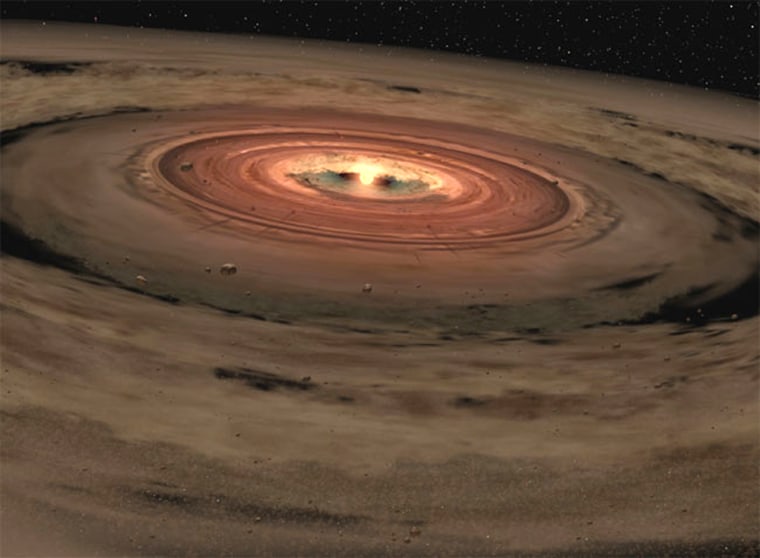Scientists have detected water vapor in the spinning disks that surround two newly formed stars, where planets are born.
A team of researchers spotted the water molecules in disks of dust and gas around DR Tau and AS 205A, which are around 457 light-years and 391 light-years, respectively, away from Earth.
The spinning disks of particles may eventually coalesce to form planets.
The discovery, set for publication in the March 20 issue of the Astrophysical Journal Letters, brings scientists one step closer to understanding water's role in Earth-like planet formation.
"This is one of the very few times that water vapor has been detected in the inner part of a protoplanetary disk – the most likely place for terrestrial planets to form," said lead researcher Colette Salyk, a graduate student in geological and planetary sciences at Caltech.
Water detection
Salyk and her colleagues analyzed light-emission data captured by NASA's Spitzer Space Telescope, finding spikes of brightness at certain wavelengths known to signal the presence of water vapor. "Only Spitzer is capable of observing these particular lines in a large number of disks because it operates above Earth's obscuring water-vapor-rich atmosphere," Salyk said.
Using this data along with more detailed information collected with instruments on the Keck II Telescope in Hawaii, the team estimated the speed and location of the water vapor molecules. "They were moving at fast speeds," Salyk said, "indicating that they came from close to the stars, which is where Earth-like planets might be forming."
As to how much water, the researchers have detected only a small amount so far, they say.
"While we don't detect nearly as much water as exists in the oceans on Earth, we see only a very small part of the disk — essentially only its surface — so the implication is that the water is quite abundant," said co-researcher Geoffrey Blake, professor of cosmochemistry and planetary sciences at Caltech.
Forming planets
The water-vapor findings could indicate that planets are forming around the stars.
For instance, Jupiter formed in our solar system as its gravitational field trapped icy solids spinning in the outer part of the sun's planetary disk. Before Jupiter gained much mass, these same icy solids could have traveled toward the star and evaporated to produce water vapor such as that seen around DR Tau and AS 205A.
The researchers have not detected icy solids around the recently studied stars. "Our observations are possible evidence for the migration of solids in the disk," Salyk said. "This is an important prediction of planet-forming models."
These initial observations portend more to come. "We were surprised at how easy it is to find water in planet-forming disks once we had learned where to look," said study team member Klaus Pontoppidan, a Caltech postdoctoral scholar and planetary scientist. "It will take years of work to understand the details of what we see."
